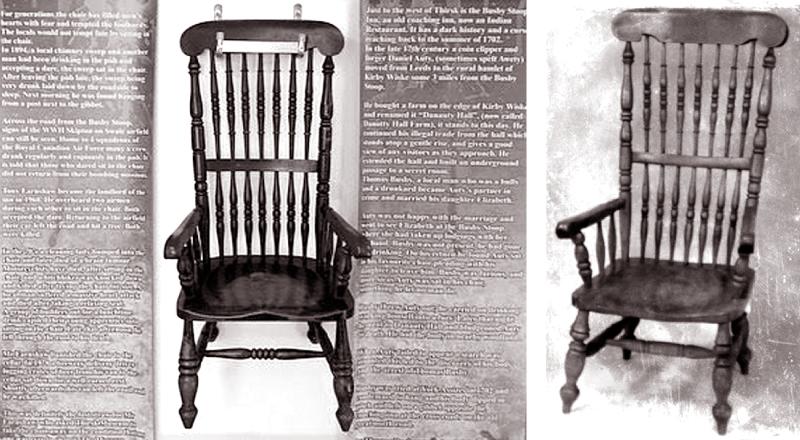
Some believe that the location of certain houses and lands bring bad luck to those who live in them. For example, when a person meets with an unexpected accident or has a sudden death, there are many people who believe that it happened because of bad luck in the house they live in or the land on which the house is built.
Such beliefs have been socialised not only in the Asian region, but also in European countries. Among the things they believe bring bad luck are not only land and houses, but also household items such as chairs, tables and clocks.
There is a chair which is believed to be such an object, called the chair of death, which has a history of more than 300 years and is housed in a museum in North Yorkshire, UK at present. The chair, which is believed to be linked to a curse by a man named Thomas Busby who lived in North Yorkshire in the 1700s, is now hanging in a museum. It is called the chair of death as several people who sat on it are said to have died unexpectedly.
Illegal activities
 Born in North Yorkshire, Thomas was a young man. Not having received much education, he engaged in various illegal activities including forging coins to earn money. He is said to have committed theft and extortion. By this time, he had developed a relationship with a young woman who lived in his village. Her father, Daniel Orty, was also a counterfeiter like Thomas.
Born in North Yorkshire, Thomas was a young man. Not having received much education, he engaged in various illegal activities including forging coins to earn money. He is said to have committed theft and extortion. By this time, he had developed a relationship with a young woman who lived in his village. Her father, Daniel Orty, was also a counterfeiter like Thomas.
Later they both started making fake coins together. During this time, Orty found out that Thomas had a relationship with his daughter, and it was strongly opposed. There were also various disagreements between them regarding the coining activities. One day, during a fight between the two over this issue, Orty was killed by Thomas.
As a result of the investigations carried out regarding Orty’s murder, the investigative units arrested Thomas in a very short time. At the end of the trial, he was found guilty of the murder and sentenced to be hanged. It is also said that the body of Thomas who was hanged was hung in a public place.
Sentenced to death, Thomas is said to have been taken to a restaurant in Sandhattan, North Yorkshire before being hanged. One tale is that he was hanged on the spot, while others say that he was taken to the restaurant to drink alcohol at his last request.
Curse
Even today, the ghost of Thomas is said to haunt the area. The ‘chair of death’ is the chair that Thomas sat in during his stay at the restaurant. He is said to have sat there for a long time and cast a curse upon it before being taken to be hanged. Legend has it that he made the curse by saying, “Death will soon follow anyone who sits in my chair.” Since then, it has been believed that almost everyone who sits in this chair dies unexpectedly.
It is said that one day in 1894, a cleaner sat on this chair and the next morning he hanged himself in a place next to it. Also, during the Second World War, a group of Canadian soldiers who stayed in a camp next to the restaurant sat on this chair to show their bravery and all of them died during the war operations.
In 1967, two Royal Air Force pilots who were sitting in this chair were killed when their car crashed into a tree on their way home. A few years later, a construction worker who was seated here fell off a roof and died a few hours later. At the same time, a cleaner who was mistakenly seated here died of a blood clot in the brain.
Tony Earnshaw, the owner of the restaurant at the time, was shocked by the unexpected deaths of many people sitting in the chairs in his restaurant. So, in 1978, he positioned it between some old beer containers so that no one could sit on it.
Museum object
However, a goods seller who came to the restaurant asked why such a comfortable chair was placed in that way and sat there. A few minutes later he also died in a car accident. Deeming it too dangerous to keep it in the restaurant any longer, Tony handed it over to the museum in Thirsk in late 1978. Even today, this chair is kept in the museum and the special feature is that it is hung on a wall so that no one can sit on it.
Historians have expressed different opinions about the legend regarding this chair. Dr. Adam Bowett, a historian who studied this, has said that some of the carvings there are machine-made. However, he noted that since such machinery did not exist in the 1700s, it was probably made in the 1840s.
Others have opined that since all the deaths associated with the chair occurred after the 1840s, there is no point in arguing about when it was made. They say that hanging it in the museum confirms that there is some mystery attached to it.
